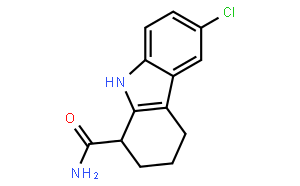
 COA COA |
 MSDS MSDS |
 HPLC HPLC |
 NMR NMR |
| CAS No: | 49843-98-3 |
| Molecular formula(MF) | C13H13ClN2O |
| Molecular Weight(MW): | 248.71 |
| Alias |
| In vitro | DMSO | 50 mg/mL (201.03 mM) |
|---|---|---|
| Ethanol | 18 mg/mL (72.37 mM) | |
| Water | <1 mg/mL | |
| In vivo | 1% DMSO+30% polyethylene glycol+1% Tween 80 | 14 mg/mL |
| Description | Selisistat (EX 527) is a potent and selective SIRT1 inhibitor with IC50 of 38 nM in a cell-free assay, exhibits >200-fold selectivity against SIRT2 and SIRT3. Phase 2. | ||||||||||||||||||||||||||||||||||||||||||||||||||||||||||||||||||||||||||||||||||||||
|---|---|---|---|---|---|---|---|---|---|---|---|---|---|---|---|---|---|---|---|---|---|---|---|---|---|---|---|---|---|---|---|---|---|---|---|---|---|---|---|---|---|---|---|---|---|---|---|---|---|---|---|---|---|---|---|---|---|---|---|---|---|---|---|---|---|---|---|---|---|---|---|---|---|---|---|---|---|---|---|---|---|---|---|---|---|---|---|
| Features | Greater potency, specificity, stability, and lower toxicity than other inhibitors of SIRT1 catalytic activity identified to date. | ||||||||||||||||||||||||||||||||||||||||||||||||||||||||||||||||||||||||||||||||||||||
| Targets |
|
||||||||||||||||||||||||||||||||||||||||||||||||||||||||||||||||||||||||||||||||||||||
| In vitro |
EX 527 exhibits potently inhibitory effect against SIRT1 deacetylase activity in a concentration-dependent manner with an IC50 of 38 nM, displays much lower activity against SIRT2 and SIRT3 with IC50 values of 19.6 μM and 48.7 μM, respectively. EX 527 does not inhibit SIRT4-7 and class I/II HDAC activity at concentrations up to 100 μM. EX-527 alone (1 μM) has no detectable effect on the acetylation of p53 lysine 382 in NCI-H460 cells. EX-527 significantly increases the amount of acetylated p53 in NCI-H460 cells, human mammary epithelial cells, U-2 OS and MCF-7 cells subjected to genotoxic agents such as Etoposide, Doxorubicin, Hydroxyurea, and Hydrogen peroxide, which is more effective than that caused by Nicotinamide (5 mM). But surprisingly EX 527 does not result in detectable effects on p53-controled gene expression, cell survival, or cell proliferation. [1] EX 527 causes a 90% increase in cell number of HCT116 cells after 7 days in the condition of 0.1% serum but not 10% serum, suggesting that SIRT1 is a significant regulator of cell proliferation during growth factor deprivation conditions. [2] EX 527 abrogates resveratrol effects on glucose responses, and prevents resveratrol-induced up-regulation of Glut2, glucokinase, Pdx-1, and Tfam in INS-1E Cells, due to the opposite effect of EX 527 and resveratrol on SIRT1 deacetylase activity. [3] |
||||||||||||||||||||||||||||||||||||||||||||||||||||||||||||||||||||||||||||||||||||||
| Cell Data |
|
||||||||||||||||||||||||||||||||||||||||||||||||||||||||||||||||||||||||||||||||||||||
| In vivo | Administration of EX 527 (~10 μg) to rats increases hypothalamic acetyl-p53 levels by inhibiting hypothalamic SIRT1 activity. Co-administration of EX 527 with ghrelin markedly blunts the orexigenic action of ghrelin by decreasing the pAMPK levels, increasing the ACC levels, and abolishing the higher expression of the transcription factors FoxO1, pCREB, and Bsx and the neuropeptides NPY and AgRP in the hypothalamic arcuate nucleus. [4] |